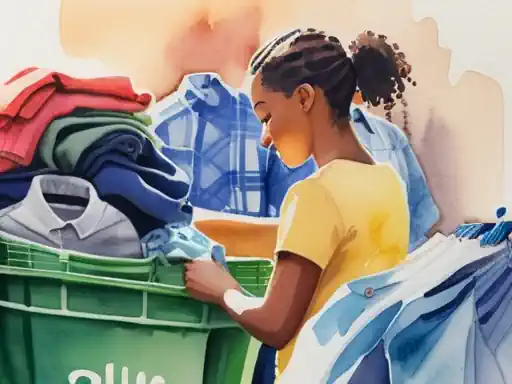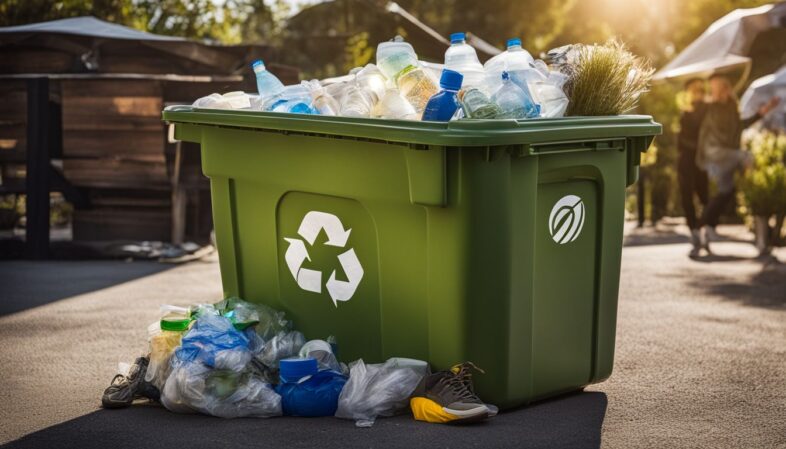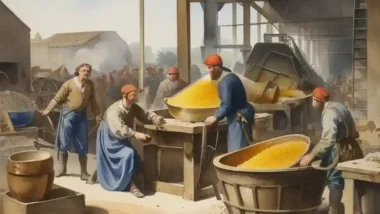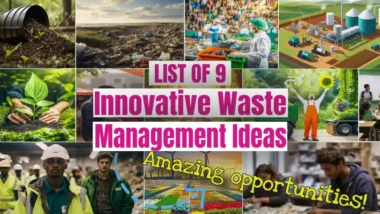Why Do We Recycle? The pressing need for recycling and the reasons to recycle.
Many people wonder if recycling truly makes a difference. It's essential to know that recycling protects our planet and conserves crucial natural resources. This article will guide you through the benefits of recycling and how it impacts both our planet and daily lives.
Keep reading to uncover the importance of this simple yet powerful act.
Key Takeaways
- Recycling saves crucial natural resources like water, timber, and minerals by turning waste into new products. This helps keep our forests fuller and oceans cleaner.
- Making items from recycled materials uses less energy than starting with raw resources. For instance, creating paper from recycled fibres cuts energy use by up to 70%.
- Properly recycling reduces harmful greenhouse gas emissions that contribute to climate change. It stops waste from ending up in landfills where it can release carbon dioxide and methane.
- Debunking myths about recycling shows it's not too complex or ineffective. Effective waste management ensures recyclable materials become new items rather than adding to landfill sites.
- The recycling industry creates jobs for young people and supports economic growth. Recycling is cheaper than disposing of waste in landfills and stimulates demand for more sustainable products.

The Environmental Benefits of Recycling
Recycling conserves natural resources, shields ecosystems, and saves significant energy. It also reduces greenhouse gas emissions and lowers the demand for raw materials.
Conserves vital natural resources
Recycling saves natural resources like water, timber, and minerals. We need these materials to make new products. By recycling paper, we use fewer trees. This means more trees are left in forests, which helps the environment.
Next up is how recycling protects ecosystems and keeps wildlife safe.
Shields ecosystems and safeguards wildlife
By conserving vital natural resources, we also take a big step in protecting our ecosystems and wildlife. This effort helps to keep forests, rivers, and oceans healthy. These places are homes for countless animals, plants, and insects.
Through recycling efforts like using less paper and plastic waste, we cut down fewer trees and reduce pollution in these habitats. This makes life better for wildlife.
Recycling also stops harmful materials from ending up in the wild areas where animals live. It prevents dangerous substances from polluting their homes or food sources. For example, when we recycle batteries properly instead of throwing them away, harmful chemicals don't leak into the ground where plants grow or water flows that animals drink.
Keeping our planet clean helps all living things thrive together.

Lowers the demand for raw materials
Protecting ecosystems and wildlife leads us to reduce the need for new raw materials. Recycling makes this possible by reusing existing waste material. This means less mining for metals, less logging in forests, and decreased drilling for fossil fuels.
All these activities harm our planet by stripping it of its natural resources.
As we recycle more, companies rely less on extracting fresh materials from the earth. This cuts down on deforestation and pollution from extraction processes. For example, making products from recycled steel saves 60% to 75% of the energy compared to using new materials.
This significant energy saving shows how recycling contributes to a more sustainable world where natural habitats are not destroyed for their resources.
Saves significant amounts of energy
Recycling uses less energy than making things from new materials. For example, producing paper from recycled fibres saves up to 70% of the energy compared to using fresh wood. I saw this first-hand when visiting a recycling facility.
Watching how quickly and efficiently they turned old newspapers into fresh sheets of paper was eye-opening. It showed me how much unnecessary energy we waste by not recycling more.
This process also means less pollution goes into our air. Making products from raw resources often releases harmful substances like carbon dioxide, a major global warming contributor.
By choosing to recycle, we cut down on these emissions significantly.
Next comes reducing greenhouse gas emissions.

Reduces greenhouse gas emissions
Recycling cuts down on greenhouse gas releases. These gases, like carbon emissions and methane, trap heat in our atmosphere. This trapping leads to climate change. By recycling materials, we make less rubbish that would otherwise end up burnt or buried in landfill sites.
Making new products from recycled material uses less energy than using fresh resources. This is crucial because producing energy often creates more greenhouse gases. So, recycling not only reduces waste but also helps in fighting air pollution and the global heating crisis.
Dispelling Common Myths about Recycling
Dispelling myths about recycling is crucial to understanding its true impact. Understanding the real recycling process helps in making informed decisions.

Debunking prevalent misconceptions
Many people think recycling is too complex and not worth the effort. This simply isn't true. Recycling involves collecting materials that would otherwise become waste and turning them into new products.
This process significantly reduces the demand for raw materials, conserves natural resources like timber and minerals, and saves energy. It's a straightforward way to support sustainable living.
Another common myth is that all recycled items end up in landfills just like regular rubbish. In fact, effective waste management systems ensure that recyclable materials are properly sorted, cleaned, and reprocessed into new products or packaging.
This cycle helps to minimise pollution of waterways from runoff and reduce greenhouse gas emissions, clearly showing how recycling makes a big difference in protecting our environment.
Clarifying the true recycling process
The true recycling process begins with sorting. We sort recycled materials like plastic, paper, and glass at local facilities. Each type of material has its own way of being reused.
For instance, recycled glass gets melted and reshaped into new products. This step is crucial to ensure that only the right items enter the recycle stream.
From my experience working in a recycling plant, I've seen firsthand how machines separate different plastics by their resin ID code. These codes tell us what kind of plastic we're dealing with—like polyethylene or polypropylene—and each type has a different recycling method.
After sorting, these plastics are cleaned to remove any food waste or other contaminants. Clean plastics are then shredded into small pieces and melted down to create new items. This cycle saves significant energy compared to producing from raw materials and reduces greenhouse gas emissions, making our environment cleaner and more sustainable.
The Economic and Social Advantages of Recycling
Recycling offers economic benefits and creates job opportunities. It is a cost-effective alternative to waste disposal methods.

Less costly compared to waste disposal
Recycling is economically advantageous as it is less expensive than waste disposal. It reduces the costs associated with transporting and dumping waste in landfills, which can be especially beneficial for local governments and waste management companies.
By diverting materials from landfills through recycling, the expenses related to managing and maintaining landfill sites are also significantly reduced.
The process of recycling itself requires less financial investment compared to traditional waste disposal methods such as landfilling or incineration. With proper sorting and processing systems in place, recycled materials can be transformed into valuable resources at a lower cost than manufacturing new products from raw materials.
This cost-effectiveness not only benefits businesses but also contributes to overall sustainability by conserving natural resources and reducing environmental impacts associated with extraction and production processes.
Creates job opportunities for young people
The recycling industry creates job opportunities for young people, supporting economic growth and sustainability. As the demand for recycling increases, so does the need for workers in collection, processing, and management of recyclable materials.
This not only helps reduce unemployment but also provides avenues for skill development and career advancement for young people in waste management and environmental conservation sectors.
Government initiatives aimed at promoting recycling can specifically target the employment of young individuals, offering them valuable experiences while contributing to a greener future.

Practical Tips for Incorporating Recycling into Everyday Life
When recycling, decipher symbols to identify what can be recycled.
Implement home practices and encourage community recycling habits.
Deciphering recycling symbols
- Recycling symbols serve as visual indicators to identify materials that can be recycled.
- The Mobius loop, commonly seen with a number inside, denotes different types of plastics suitable for recycling.
- The Green Dot symbol signifies that the producer has made a financial contribution towards the recovery and recycling of packaging in some European countries.
- The chasing arrows symbol is often misunderstood to mean an item is recyclable, but it actually indicates the material's ability to be recycled and not its current recyclability.
- The ‘Compostable' symbol, featuring a leaf and the letters ‘PLA', represents products that can break down into natural elements under specific conditions.
- The Resin Identification Code (RIC), represented by a number inside a triangle of arrows, identifies the type of plastic resin used in an item.
- Understanding these symbols empowers individuals and communities to make informed decisions about recycling practices and contribute to a more sustainable future.
- Familiarity with these symbols can help reduce contamination in recycling streams, leading to higher-quality materials for reuse.

Suggestions for Home Recycling Practices
Here are some practical tips for incorporating recycling into your everyday life:
- Set up a designated recycling area in your home, making it convenient and accessible for everyone to use.
- Educate yourself and your family about what can and cannot be recycled, and find out where local recycling facilities are located.
- Use separate bins for different types of recyclables, such as paper, plastics, glass, and metal, to make sorting easier.
- Rinse out food containers before recycling them to prevent contamination that can render items unrecyclable.
- Reuse any suitable items before recycling them, such as jars, containers, and bags.
- Consider composting organic waste rather than throwing it away, reducing the amount of household waste sent to landfills.
- Encourage others in your community to recycle by sharing information on the benefits of recycling and leading by example.
- Explore creative ways to upcycle items that might otherwise be discarded, giving them new life instead of adding to landfill waste.
- Look for products with minimal packaging or packaging made from recycled materials when shopping to reduce waste generation at home.
- Support initiatives within your community that promote sustainable living practices, such as participating in local clean-up events or educating others about the importance of recycling.
These suggestions can help you integrate recycling into your daily routine, contributing to a more sustainable future for our planet.

Encouraging recycling habits among communities
To encourage recycling in communities, initiate educational campaigns about the benefits of recycling and how it positively impacts the environment. Collaborate with local schools and community centres to organise workshops and events to raise awareness.
Implement incentive programmes to reward households and businesses that actively participate in recycling efforts, promoting a sense of community involvement.
Engaging with local leaders and stakeholders is crucial for creating effective recycling initiatives within communities. By fostering partnerships with businesses, NGOs, and government organisations, we can work together to develop sustainable waste management systems tailored towards each community's specific needs.
Through these concerted efforts, we can instil a culture of environmental responsibility that will reverberate across generations.
Conclusion
Recycling has numerous benefits for the environment and society. It conserves natural resources, reduces waste in landfills, and lessens pollution and greenhouse gas emissions. Recycling also saves energy, stimulates the economy, and minimises deforestation and habitat destruction.
By making small changes in our daily lives, we can contribute to a greener future for future generations. Let's take action by incorporating these practical tips into our routines.
The impact of recycling is far-reaching – it's time to make a difference!

FAQs
1. Why should we recycle?
We recycle to reduce waste, save natural resources like trees and water, and decrease pollution. Recycling helps keep the environment clean and fights climate change by lowering greenhouse gas emissions.
2. What happens if we don't recycle items like plastic?
If we don't recycle plastics, they can end up polluting our land and oceans, harming wildlife. Plastics that aren't recycled can break down into microplastics, contaminating our food chain.
3. Can recycling help with climate emergencies?
Yes, recycling reduces greenhouse gases which are responsible for climate emergencies. By recycling materials like paper and aluminium instead of making them from scratch, we use less energy which means releasing fewer harmful gases into the atmosphere.
4. Is everything I throw away recyclable?
Not everything is recyclable in your bin at home. Items like clingfilm, soiled foil or bin liners often cannot be recycled because they're made from materials that are difficult to process or are contaminated with food waste.
5. How does recycling save animals and forests?
Recycling saves animals' homes by reducing the need to take resources from their habitats such as virgin rainforests for paper production or mining areas for metals like aluminium used in cars.
6. What's better: recycling or upcycling?
Both are good! Recycling turns items into similar products while using less energy than making them new again; upcycling creatively transforms waste into higher quality goods without breaking it down first.







